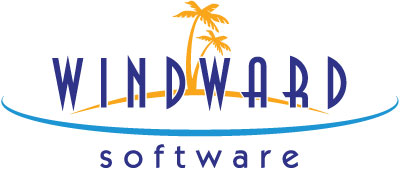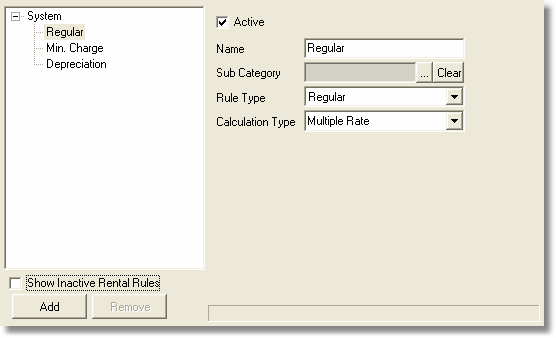
 |
|
See also: Inventory - Rental Rates tab
There is no limit to the number of rules that can be created, but keeping the rules as simple as possible is recommended. Creating a specific rule for every Sub Category would be extremely cumbersome, so it is best to limit the use of Sub Category specific rules as exceptions to the System wide rules. By default, there are three System wide rules created, Regular, Min. Charge and Depreciation, as shown in Figure 1.

Figure 1: The Rental Rules window
Rental rules can be changed at any time, however, when you change the Calculation Type a warning dialog box appears stating that changing the rental rules may cause irregular pricing when completing open work orders or doing rental returns that spans the two rules. An example is where the rental date starts with one rule valid but ends with the other rule valid.
Each of the controls on the Rules Setup window are detailed in Table 1:
|
Control |
Purpose |
|
The Rule Tree |
The Rules are displayed in an expandable and collapsible tree in the upper left portion of the Rules window. In the example in Figure 1 the tree has only one branch (System) and two sub-branches (Control Label and Min. Charge).
By using the Move Up and Move Down menu items you can sort the tree as desired. |
|
Show Inactive Rental Rules |
Check this box to display any inactive Rental Rules in the Rules tree. |
|
[Add] |
Click [Add] to add a new rule to the tree. System Five will present the dialog shown in Figure 3:
Type in the name for the new Rule and click [OK]
|
|
[Remove] |
Click [Remove] to remove the currently selected Rule from the tree. If the [Remove] button is disabled, the currently selected Rule has been used and therefore cannot be removed.
|
|
Active |
This check box controls the Rules status. Only Active Rules are considered by System Five. The ability to make a Rules Inactive provides a method of hiding the Rule when it is no longer required. You cannot remove a Rule once it has been used. Note: Only one Rule of each Rule Type can be Active within the System or Sub Category branches at any given time. |
|
Name |
This box contains the name of the Rule. The Name is limited to 20 characters. You can modify the name as required. It is important to note that when the Rule Type is Min. Charge, the text entered here will be used as the Minimum Charge description wherever rates are displayed, such as in the Inventory Edit window, Rent Scheduler window and rental In/Out Time Entry window. |
|
Sub Category |
This control provides a method of selecting a specific Sub Category for a Rule. By using this control, you can create general rules that apply to the majority of Rental Parts and then create special case rules for entire Sub Categories. The background of the Sub Category control appears in grey, this indicates that you cannot type in the control, you must use the ellipse button on the right to open the Sub Category selection dialog. The [Clear] button allows you to remove the Sub Category selection completely, in which case the Rule would automatically become a System wide rule. |
|
Rule Type |
There are 3 Rule Types to choose from, as shown in Figure 6:
Regular: The Regular Rule Type refers to a general rule that applies to the Rental Rates. |
|
Calculation Type |
Note: Once a Rule has been used, the Calculation Type can no longer be edited.
One Rate: The One Rate calculation type provides a single Rental Rate that is used to calculate all Rental charges, regardless of the length of the rental. |
|
Do not use in this Sub Category |
(Applies to the Min. Charge and Depreciation (% of Charge) rules within specified Sub Categories only) |
Table 1: The Rental Rules setup controls